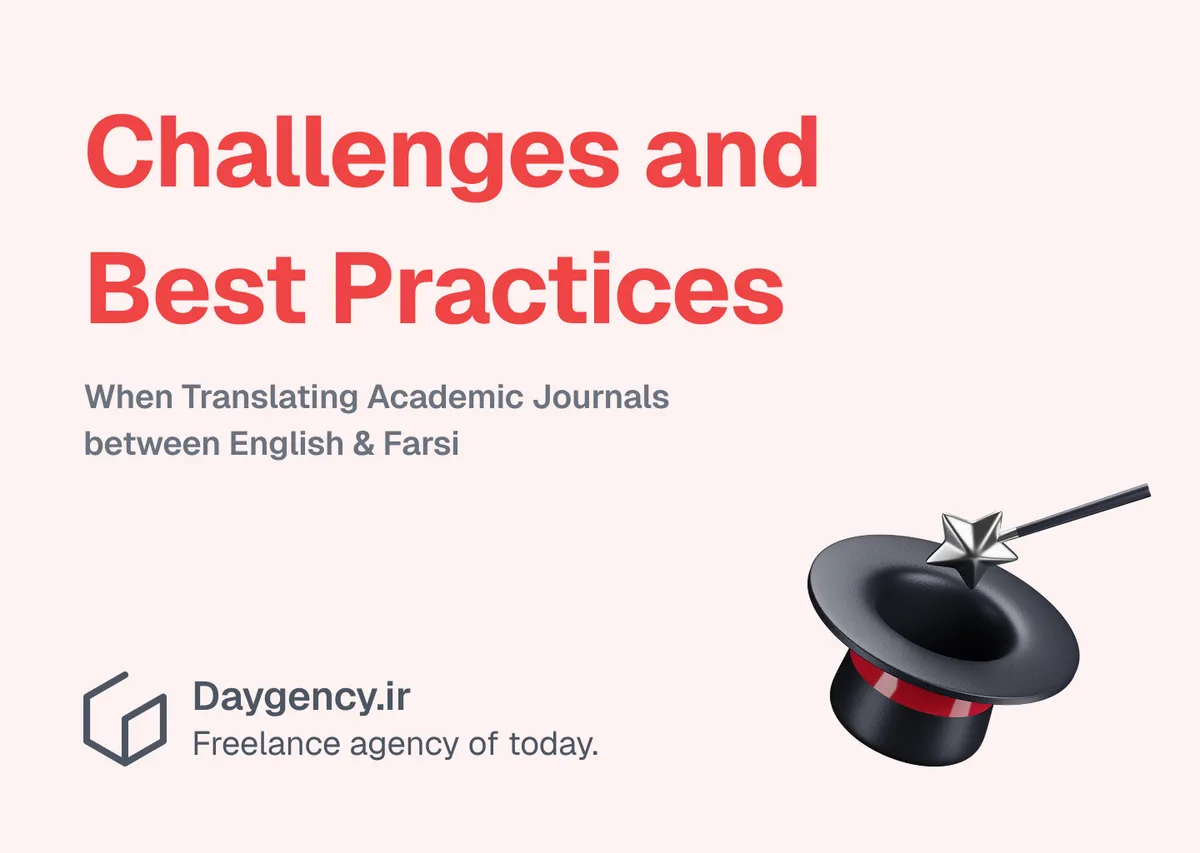Translating academic journals from Farsi to English (and vice versa) is a complex and nuanced process. Unlike casual or business translations, academic texts demand precision, consistency, and adherence to scholarly standards. Even minor errors can distort the meaning, misrepresent the author’s intent, or reduce the credibility of the work.
In this article, we’ll explore the key challenges of translating academic journals and outline best practices to ensure accuracy, preserve the scholarly tone, and maintain the integrity of the original work.
The Challenges of Translating Academic Journals
- Complex and Specialized Terminology
Academic journals often contain technical terms, discipline-specific jargon, and complex concepts. Incorrect or inconsistent translations of these terms can significantly impact the meaning and credibility of the content.
Challenge:
Finding accurate, context-appropriate equivalents for specialized terminology.Example:
In medical or scientific journals, mistranslating a clinical term could result in misinterpretation of findings.Best Practice:
- Use bilingual academic glossaries and term banks specific to the field of study.
- Refer to published academic works in the target language to ensure consistency with standard terminology.
- Collaborate with subject-matter experts (SMEs) when translating highly specialized content.
- Maintaining the Scholarly Tone and Style
Academic journals have a formal, precise, and objective tone. Translating them requires preserving the original writing style, including its academic rigor.
Challenge:
Over-literal translation or informal phrasing can undermine the scholarly nature of the text.Example:
- Farsi: _این مطالعه به بررسی تاثیر سیاستهای اقتصادی بر بازار سرمایه ایران میپردازد._
- Poor translation: "This study looks at how economic policies impact Iran’s capital market."
- Better translation: "This study examines the impact of economic policies on Iran’s capital market."
- The second version uses more formal and academic phrasing, better suited for a journal article.Best Practice:
- Use academic-style sentence structures that reflect the tone of the original work.
- Reference existing scholarly publications in the target language to mirror the appropriate writing style.
- Proofread the translation to eliminate casual or colloquial expressions.
- Consistency in Terminology and Style Across the Journal
Journals often include repeated terms, phrases, and references, which must be translated consistently throughout the text.
Challenge:
Inconsistent terminology confuses readers and reduces the credibility of the translation.Example:
In a legal journal, switching between "contract" and "agreement" for the same term creates ambiguity.Best Practice:
- Use translation memory (TM) tools or terminology management software to ensure consistent terminology.
- Create a style guide or glossary for the journal to ensure uniformity across articles.
- Perform a final consistency check to verify that terminology, phrasing, and tone are consistent.
- Accurate Citation and Bibliography Translation
In academic journals, citations, footnotes, and bibliographies must follow specific formatting and referencing styles (APA, MLA, Chicago, etc.).
Challenge:
Improper translation or formatting of references can lead to plagiarism issues or citation errors.Example:
- Farsi reference: _محمدی، علی. اقتصاد کلان. تهران: نشر نی، ۱۳۹۹._
- Correct English translation: Mohammadi, Ali. Macroeconomics. Tehran: Nashr-e Ney, 2020.
- The translator must convert the publisher’s name, year, and city into the appropriate English format.Best Practice:
- Follow the journal’s referencing guidelines (APA, MLA, etc.) precisely.
- Verify that all citations are properly translated and formatted according to the required style.
- Use reference management software (e.g., Zotero, EndNote) for consistent citation formatting.
- Handling Cultural and Linguistic Nuances
Academic texts often include culturally specific references, idioms, or concepts that may not have direct equivalents in the target language.
Challenge:
Translating culturally embedded terms while preserving the meaning and context.Example:
- Farsi: ریال
- Literal translation: "Rial"
- Appropriate translation: "Iranian Rial (IRR)" to clarify the currency for an international audience.Best Practice:
- Use clarifying annotations when necessary to explain cultural references.
- Add translator’s notes or parenthetical explanations for unfamiliar terms.
- When possible, localize measurements, dates, and currency for the target audience.
Best Practices for High-Quality Academic Journal Translations
- Work with Academic Translation Specialists
Academic translation demands subject-matter expertise and familiarity with academic writing conventions.
Why It Matters:
General translators may miss technical nuances or fail to capture the scholarly tone.Best Practice:
- Hire experienced academic translators familiar with the relevant field.
- Use bilingual subject-matter experts to review the translation for accuracy.- Proofread and Edit for Academic Quality
Even skilled translators can overlook stylistic or grammatical issues.
Why It Matters:
Academic journals require flawless language, grammar, and formatting.Best Practice:
- Use native-speaking editors to proofread and refine the text.
- Conduct a double review process: one for language accuracy and another for academic style and consistency.- Use Technology Wisely (but Not Exclusively)
While CAT tools and machine translation can improve efficiency, they should not replace human expertise.
Why It Matters:
Machines lack the ability to interpret academic nuance and cultural context.Best Practice:
- Use CAT tools for consistency and speed but rely on human translators for final editing.
- Implement quality assurance (QA) checks to catch inconsistencies or awkward phrasing.- Prioritize Confidentiality and Data Security
Academic journals often contain sensitive, unpublished research. Protecting this information is crucial.
Why It Matters:
Breaches of confidentiality can jeopardize the credibility and originality of the research.Best Practice:
- Sign non-disclosure agreements (NDAs) with translators.
- Use secure file-sharing platforms.
- Ensure strict data protection protocols.Key Takeaways: Ensuring High-Quality Academic Journal Translations
- Master subject-specific terminology and use consistent language throughout the text.
- Preserve the academic tone by mirroring formal, scholarly language.
- Maintain citation accuracy according to the journal’s referencing style.
- Proofread rigorously to catch grammatical, stylistic, and formatting errors.
- Collaborate with academic experts for specialized or technical content.
- Prioritize confidentiality and secure handling of sensitive information.
Need Professional Academic Translation Services?

Our agency specializes in Farsi-English academic journal translation, ensuring accuracy, cultural sensitivity, and scholarly precision. Whether you’re a researcher, professor, or publisher, we help you reach a global audience with clear, professional translations.
Contact us today for expert academic translation services that meet the highest standards!
